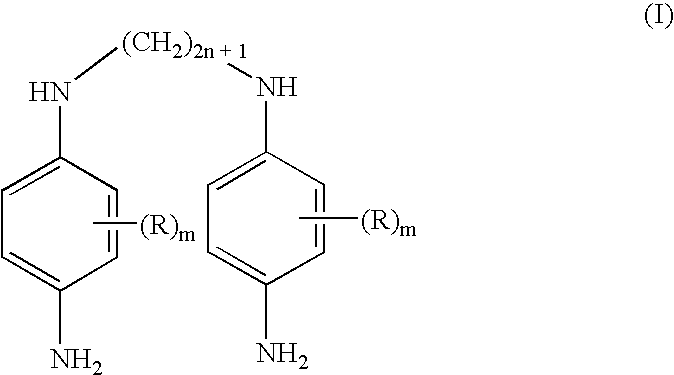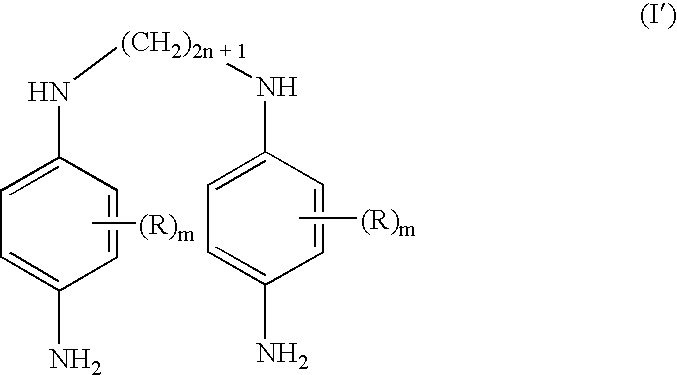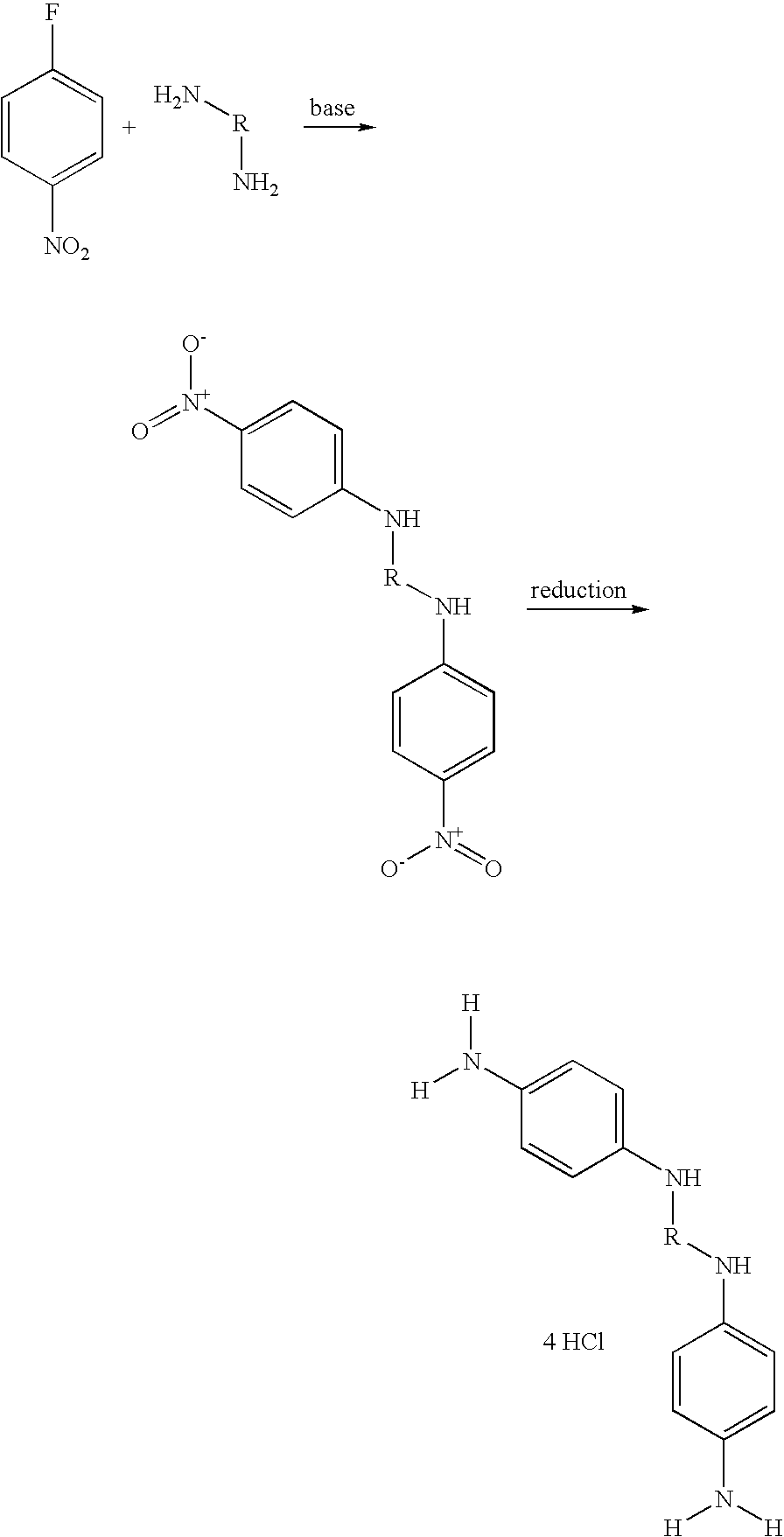Double secondary para-phenylenediamine compounds, dye compositions comprising same, and dyeing process using the compositions
- Summary
- Abstract
- Description
- Claims
- Application Information
AI Technical Summary
Problems solved by technology
Method used
Image
Examples
example 1
Synthesis of 1,3-bis(4-aminophenylamino)propane tetrahydrochloride (2)
[0116]
Step 1: Synthesis of N,N′-bis(4-nitrophenyl)-1,3-propanediamine (1)
[0117]5 g of 4-fluoronitrobenzene (35 mmol) were dissolved in 5 ml of DMSO. 1 equivalent of 1,3-diaminopropane and 2.2 equivalents of triethylamine were added to the solution. The reaction medium was maintained at 60° C. for 20 hours. The mixture was then poured onto crushed ice, and a precipitate formed. This precipitate was filtered off, washed with water and then dried.
Step 2: Synthesis of 1,3-bis(4-aminophenylamino)propane tetrahydrochloride (2)
[0118]In a 1 liter hydrogenator, the nitro compound (1) was dissolved in 500 ml of ethanol. 10% palladium on charcoal (50% water) was added and the hydrogenator was charged with hydrogen. After reaction for 1 hour 30 minutes, the palladium was filtered off and 20 ml of 3M hydrochloric ethanol and then 300 ml of isopropyl ether were added to the filtrate. The precipitate obtained was filtered off an...
example 2
Synthesis of 1,3-bis(4-aminophenylamino)pentane tetrahydrochloride (4)
[0120]
Step 1: Synthesis of N,N′-bis(4-nitrophenyl-1,3-pentanediamine (3)
[0121]1.15 g of 4-fluoronitrobenzene (8.15 mmol) were dissolved in 5 ml of DMSO. 1 equivalent of 1,5-diaminopentane and 4 equivalents of triethylamine were added to the solution. The reaction medium was maintained at 60° C. for 20 hours. The mixture was then poured onto crushed ice, and a precipitate formed. This precipitate was filtered off, washed with water and then dried.
Step 2: Synthesis of 1,3-bis(4-aminophenylamino)pentane tetrahydrochloride (4)
[0122]In a 1 liter hydrogenator, the nitro compound (3) was dissolved in 500 ml of ethanol. 10% palladium on charcoal (50% water) was added and the hydrogenator was charged with hydrogen. After reaction for 1 hour 30 minutes, the palladium was filtered off and 20 ml of 3M hydrochloric ethanol and then 300 ml of isopropyl ether were added to the filtrate. The precipitate obtained was filtered off ...
example 3
Synthesis of N4-{3-[(4-amino-3-methylphenyl)amino]propyl}-2-methylbenzene-1,4-diamine tetrahydrochloride (6)
[0124]
Step 1: Synthesis of N,N′-bis(3-methyl-4-nitrophenyl)-1,3-propanediamine (5)
[0125]1.5 g of 5-fluoro-2-nitrotoluene (9.67 mmol) were dissolved in 10 ml of DMSO. 1.2 equivalents of 1,3-diaminopropane and 1.2 equivalents of triethylamine were added to the solution. The reaction medium was maintained at 80° C. for 24 hours. The mixture was then poured onto crushed ice, and a precipitate formed. This precipitate was filtered off, washed with water and then dried.
Step 2: Synthesis of N4-{3-[(4-amino-3-methylphenyl)amino]propyl}-2-methylbenzene-1,4-diamine tetrahydrochloride (6)
[0126]The product obtained during the preceding step, compound (5), was reduced with a boiling zinc / ammonium chloride / water / ethanol mixture. The corresponding amine was isolated in tetrahydrochloride form.
[0127]The proton NMR and mass spectra were in accordance with the expected structure of the product....
PUM
| Property | Measurement | Unit |
|---|---|---|
| Fraction | aaaaa | aaaaa |
| Fraction | aaaaa | aaaaa |
| Fraction | aaaaa | aaaaa |
Abstract
Description
Claims
Application Information
 Login to View More
Login to View More - Generate Ideas
- Intellectual Property
- Life Sciences
- Materials
- Tech Scout
- Unparalleled Data Quality
- Higher Quality Content
- 60% Fewer Hallucinations
Browse by: Latest US Patents, China's latest patents, Technical Efficacy Thesaurus, Application Domain, Technology Topic, Popular Technical Reports.
© 2025 PatSnap. All rights reserved.Legal|Privacy policy|Modern Slavery Act Transparency Statement|Sitemap|About US| Contact US: help@patsnap.com



